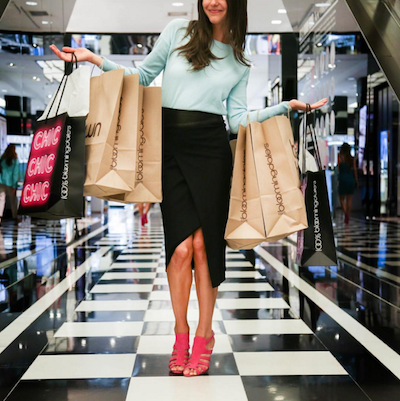SAN FRANCISCO – Consumer behavior and values shifted drastically with the 2008 recession, creating cause for concern for those who rely on consumer spending.
An executive from MasterCard Advisors explained that much like the “Depression babies” of decades ago, today’s consumers are more conscientious about what they buy. This requires a changed strategy to acquire new clients and convince them to shop.
“I don’t believe that people have the same values as they did before,” said Sarah Quinlan, vice president and group head of market insights at MasterCard Advisors.
“It’s a secular shift to understand that we like our family and friends again,” she said. “Before we really just liked stuff much more.
So this sense of how we’re actually buying. It doesn’t mean we don’t like the experiences of luxury, so going in and buying something special. We will create experiences out of luxury goods that we purchase, but I don’t think we will buy them as continually.”
Current climate
The United States has seen its retail sales grow year-over-year, while other markets show slowed growth.
One consideration for brands in the U.S. market is reaching time-strapped consumers when they can shop. This means being accessible for the lunch rush and the post-work shopping trips consumers take, as well as capturing women’s 10 p.m. online shopping surge.
Online channels only account for 7.6 percent of luxury spending in the U.S., but consumers are using digital as a research tool, with 85 percent using a mobile device to look up merchandise before making a purchase through another channel.

Image courtesy of Neiman Marcus
Some key hurdles to getting consumers shopping online are safety and security and time. For women’s apparel, giving an understanding of a unique material or helping consumers envision what they will look like in a particular garment will help boost the online shopping experience.
Consumers are also changing where they want to shop for apparel. Department stores are losing their appeal for U.S. shoppers, particularly millennials.
One challenge facing brands is the rise of the casual work wardrobe. Whereas consumers used to have one set of clothing for the workweek and one for the weekend, today many consumers wear the same items across their lives.
There is therefore less need to buy clothing, requiring retailers to discount to drive sales.
Spending on luxury, for instance jewelry, is also down in the U.S., which Ms. Quinlan partially attributes to consumers’ desire to save. Mid-tier price points are faring better than pieces with higher retail prices.
“The 1 percent stay the 1 percent because they don’t spend,” she said.
Consumers have moved closer to their places of work, resulting in smaller living spaces. They are therefore not looking to accumulate things, instead buying mostly when they need to replace something.

Image courtesy of Bloomingdale’s
Now in the “turbulent teens” of the 21st century, luxury consumers are changing their mindset, forcing brands to evolve along with them, according to an executive from The Future Laboratory at the U.S. Retail & Luxury Futures Forum on Oct. 21.
Presenting the results of a survey of United Kingdom and United States consumers it conducted this summer, The Future Laboratory found that “luxurians” in these countries are generally seeking out experiences over goods, craving a meaningful human connection from the brands they interact with. Brands need to respond with interactions that play to consumers’ intangible desires that exist outside of material ownership (see story).
According to Ms. Quinlan, one of the best times to reach U.S. consumers is during their vacations.

U.S. consumers are spending on travel
Airline sales are the highest they have ever been in the U.S., and their spending on lodging has risen with it.
While on vacation, the consumers who are difficult to reach while they are working are rich with time, and they shop accordingly. They tend to buy from the labels they are familiar with, making reaching them locally before they embark on a trip important.
Global outlook
It is particularly important for brands to focus on the U.S. since it has become more difficult to convince tourists from other nations to come to the U.S. to shop.
China, which has been a large growth provider for luxury, is slowing in particular categories, including jewelry, due to the crackdown in corruption.
In the short term, French apparel and accessories brand Louis Vuitton is on pace to have the best momentum among luxury houses during the Year of the Monkey, per Exane BNP Paribas.
Exane BNP Paribas’ “Chinese Luxury: The Year of Monkey Business” report looks at the current economic climate of China and how the slowdown is impacting luxury brands with a presence in the Mainland and Hong Kong markets. While many brands are concerned regarding the slowdown in Chinese spending, the financial firm suggests that growth for 2016 will match the year-ago (see story).
The crackdown is not only in China, but also in countries and regions such as Brazil, Russia and the Middle East.
“I don’t think we’ve seen the numbers come back to where they were because one of the things we have is a more transparent world thanks to innovation,” Ms. Quinlan said.
“It’s not so easy to hide behind some of those things,” she said. “For example, if you buy a home in New York or Miami now, you have to declare the providence of the wealth. I think there’s a big evolution here that we’re seeing in that regard.”
from
http://redirect.viglink.com?u=http%3A%2F%2Fredirect.viglink.com%2F%3Fu%3Dhttps%253A%252F%252Fwww.luxurydaily.com%252Fpre-recession-sales-unlikely-to-return-says-mastercard-advisors-exec%252F%26amp%3Bkey%3Dddaed8f51db7bb1330a6f6de768a69b8&key=ddaed8f51db7bb1330a6f6de768a69b8

No comments:
Post a Comment